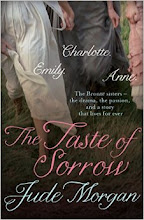But I'm rushing ahead of myself. Let's back up a wee way.
Corrag has had mixed reviews in the press. I remember looking at Oystercatchers, Fletcher's second novel, a couple of years ago, and though the story didn't appeal at the time, I was drawn in by the style and poeticism, and it went on a "to buy" list, but was never bought. Corrag, however, I leapt at, for two reasons. Firstly, as I have mentioned previously, I am, as Corrag herself would say, "for places". I love stories that are set in specific landscapes, where that landscape is as much a part of the book as are the characters, where the land itself is a protagonist. The Bronte's and Hardy epitomise this style of writing, and Lorna Doone is my favourite 'Classic' - I'm for wildness and savagery, wind and storms and snowdrifts, crags and peaks. Corrag is set in my favourite of all such places, my favourite place on earth: the Scottish Highlands.
 That was the first reason I was drawn to Corrag.
That was the first reason I was drawn to Corrag.The second was, quite simply, that when I sat down and read the first chapter, the beauty of the language was such that I could barely breathe, and I had to read the chapter again before my lungs were well enough to carry on.
Corrag is written as, essentially, a monologue, the voice that of the eponymous heroine, a young seventeenth century woman accused of witchcraft and awaiting her death sentence. Chained and starving in a stone cell, she is visited by churchman and Jacobite, Charles Leslie, who hears that she was at Glencoe a few weeks previously when the Macdonald clan were slaughtered in their beds by soldiers they had been sheltering for the winter.

The bones of the story, then, are fact. The flesh is added by Fletcher. And what flesh! Corrag's voice is so perfect, so beautiful, so poetic, that after living inside her head for the past six days, this - what I write now - feels plodding and heavy, clumsy. I am almost embarrassed to be commenting on Fletcher's ability as a writer - no, she is not a writer, she is a wordsmith - in this dull, thick prose. I can open Corrag at random and find lyricism in any line. Listen to this:
"...the heart has its scars. It has its spaces, so that I wondered if it whistled when the wind was strong. I wondered if it leaked, on rainy days. A heart with holes in it."
Change the form, and you have verse:
The heart has its scars.It has its spaces,
so that I wondered if it whistled
when the wind was strong.
I wondered if it leaked,
on rainy days.
A heart
with holes in it.
Corrag has sent me spinning into a tizzy. Its lightness of image and delicacy of phrase sends one soaring over the ridges it describes. It is a tale of heart-rending murder recounted with compassion in every syllable, at its core a character - oh, but she is so much more than that flat word conveys! - whose desperate, divine life is lesson to us all.
I sense that we will hear a lot more from and about Susan Fletcher in the coming years. Most talk will be of her wordcraft. She is a force of letters, and I urge you to let her use her power to transport you as she has me. Corrag is a book about the deadly yet redeeming strength of nature, of love... and of words themselves. Corrag talks of the words that make people and that change people, that cause wars, that hang innocents: "witch", "hag", "king" and a raft of others. She is naive, but she listens, and she sees the layers that lie behind what she hears. Don't let the cover of this book - another wistful woman in a desolate landscape - put you off. Like Corrag, look at what is behind the first impression.














